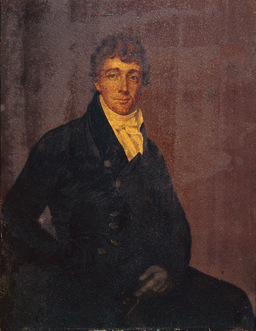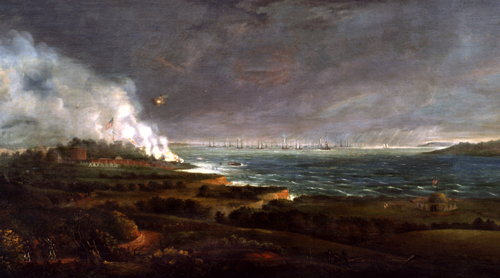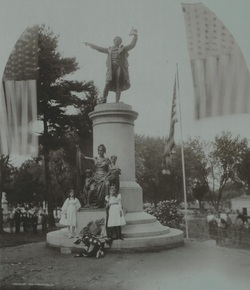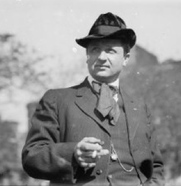FRANCIS SCOTT KEY
The final resting place of Francis Scott Key, the man who penned "The Star-Spangled Banner," is located within walking distance of historic Downtown Frederick in Mount Olivet Cemetery. Just within the front gates, stands an impressive monument dedicated on August 9th, 1898 to pay lasting tribute to the Frederick native who authored our national anthem.

LIFE OF THE AUTHOR
Francis Scott Key was born in Frederick County on August 1st, 1779 at his family's plantation estate of Terra Rubra. Today this area is now part of Carroll County, Maryland. The son of a Revolutionary war lieutenant, Key studied law in the state capital of Annapolis. He would come back home to Frederick to begin his legal practice in 1801. Francis Scott Key's sister Anne married Roger Brooke Taney, another Frederick attorney, and later, the fifth Chief Justice of the United States Supreme Court.
Francis Scott Key wed Mary Tayloe Lloyd of Annapolis. The couple had a large family consisting of 11 children (6 sons/5 daughters). Key would eventually relocate the family to Georgetown in an effort to conduct his law career in the nation's capital in association with his uncle, Philip Barton Key.
Throughout his lifetime, Francis Scott Key was a dutiful Christian and once considered entering the ministry. Instead, he decided to use his talent as a strong writer, effective speaker and quick, logical thinker in the courts of law. From 1833-1841, Key would serve as U.S. Attorney for the District of Columbia.
Francis Scott Key died in Baltimore, Maryland on January 11th, 1843 at the home of his daughter, Mrs. Elizabeth Howard.
Francis Scott Key was born in Frederick County on August 1st, 1779 at his family's plantation estate of Terra Rubra. Today this area is now part of Carroll County, Maryland. The son of a Revolutionary war lieutenant, Key studied law in the state capital of Annapolis. He would come back home to Frederick to begin his legal practice in 1801. Francis Scott Key's sister Anne married Roger Brooke Taney, another Frederick attorney, and later, the fifth Chief Justice of the United States Supreme Court.
Francis Scott Key wed Mary Tayloe Lloyd of Annapolis. The couple had a large family consisting of 11 children (6 sons/5 daughters). Key would eventually relocate the family to Georgetown in an effort to conduct his law career in the nation's capital in association with his uncle, Philip Barton Key.
Throughout his lifetime, Francis Scott Key was a dutiful Christian and once considered entering the ministry. Instead, he decided to use his talent as a strong writer, effective speaker and quick, logical thinker in the courts of law. From 1833-1841, Key would serve as U.S. Attorney for the District of Columbia.
Francis Scott Key died in Baltimore, Maryland on January 11th, 1843 at the home of his daughter, Mrs. Elizabeth Howard.
 The bombardment of Baltimore's Fort McHenry, September 13-14, 1814.
The bombardment of Baltimore's Fort McHenry, September 13-14, 1814.
THE NATIONAL ANTHEM
During the War of 1812, Francis Scott Key was summoned to gain the release of a friend, Dr. William Beanes, captured by invading British forces in late August, 1814. Together with Col. John Skinner, an American agent for prisoner exchange, Key set sail for Baltimore under a flag of truce approved by President James Madison. At first the British refused to give up the physician from Upper Marlboro, but eventually relented. However, the three would be detained aboard a British sloop during the naval bombardment of Fort McHenry in the Baltimore Harbor.
The battle commenced in the early morning of September 13th and lasted for 25 hours. all the while with Key, Skinner and Beanes witnessing from their unique vantage point. When daylight came, the three men were astonished to see the 15-star American flag still flying atop Fort McHenry.
An amateur poet, Francis Scott Key was inspired to write his thoughts on the back of a letter. This impromptu scribbling would become a masterful work of prose, originally titled "The Defence of Fort McHenry." Days later, Key's ode to the national flag would appear in local newspapers. Within weeks, it would be reprinted in publications across the land.
Words were put to music and the song was adopted as the American national anthem, first by an executive order from Woodrow Wilson in 1916 and then by a Congressional resolution in 1931, signed by President Herbert Hoover.
During the War of 1812, Francis Scott Key was summoned to gain the release of a friend, Dr. William Beanes, captured by invading British forces in late August, 1814. Together with Col. John Skinner, an American agent for prisoner exchange, Key set sail for Baltimore under a flag of truce approved by President James Madison. At first the British refused to give up the physician from Upper Marlboro, but eventually relented. However, the three would be detained aboard a British sloop during the naval bombardment of Fort McHenry in the Baltimore Harbor.
The battle commenced in the early morning of September 13th and lasted for 25 hours. all the while with Key, Skinner and Beanes witnessing from their unique vantage point. When daylight came, the three men were astonished to see the 15-star American flag still flying atop Fort McHenry.
An amateur poet, Francis Scott Key was inspired to write his thoughts on the back of a letter. This impromptu scribbling would become a masterful work of prose, originally titled "The Defence of Fort McHenry." Days later, Key's ode to the national flag would appear in local newspapers. Within weeks, it would be reprinted in publications across the land.
Words were put to music and the song was adopted as the American national anthem, first by an executive order from Woodrow Wilson in 1916 and then by a Congressional resolution in 1931, signed by President Herbert Hoover.

THE MONUMENT
Following his death in 1843, Francis Scott Key reposed in St. Paul's Cemetery in Baltimore within the Howard family crypt. After the Civil War, a contingentof leading Frederick residents lobbied Key's children to re-inter the author in their "new" rural cemetery in his beloved, native home. They obliged, and Francis Scott Key's remains were brought to Mount Olivet in 1866.
Local citizens formed the Francis Scott Key Monument Association, organized to plan for an appropriate memorial for the author of "The Star-spangled Banner." Fundraising efforts totaled $30,000, most of which was contributed by school children and others from around the country. The monument was dedicated on August 9th, 1898 amidst a flurry of local, state and national fanfare and newspaper coverage.
Following his death in 1843, Francis Scott Key reposed in St. Paul's Cemetery in Baltimore within the Howard family crypt. After the Civil War, a contingentof leading Frederick residents lobbied Key's children to re-inter the author in their "new" rural cemetery in his beloved, native home. They obliged, and Francis Scott Key's remains were brought to Mount Olivet in 1866.
Local citizens formed the Francis Scott Key Monument Association, organized to plan for an appropriate memorial for the author of "The Star-spangled Banner." Fundraising efforts totaled $30,000, most of which was contributed by school children and others from around the country. The monument was dedicated on August 9th, 1898 amidst a flurry of local, state and national fanfare and newspaper coverage.
 Sculptor Pompeo Coppini (1870-1957)
Sculptor Pompeo Coppini (1870-1957)
The bronze statue of Francis Scott Key is significant as an outstanding example of the work of sculptor Pompeo Coppini. Coppini, a young Italian immigrant, was in the employ of Alexander Doyle, a noted New York designer of the 19th century. He worked diligently on the statue, and during the process fell in love with (and later married) his sitting model for Columbia depicted at the statue's base. Other works by Coppini exist in Washington DC, Chicago and San Antonio, Texas, the latter home to the artist's well-known Alamo Cenotaph.
A resolution by Congress is responsible for the flag being flown continuously over the Francis Scott Key Memorial and gravesite since May 30th. 1949. Within a few hundred yards of Francis Scott Key's final resting place is Harry Grove Stadium, home to the local minor league baseball team-the Frederick Keys.
A resolution by Congress is responsible for the flag being flown continuously over the Francis Scott Key Memorial and gravesite since May 30th. 1949. Within a few hundred yards of Francis Scott Key's final resting place is Harry Grove Stadium, home to the local minor league baseball team-the Frederick Keys.
